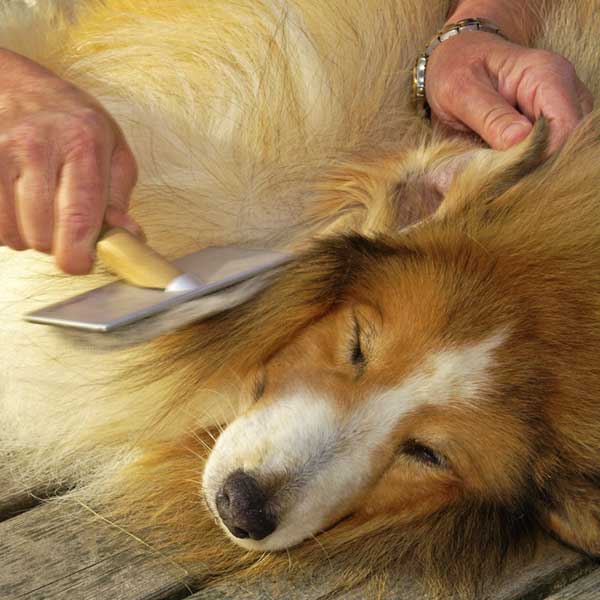They say that a pet never leaves your mind or heart –- and how can it when you spend all day at work picking strands of dog hair off your clothes? Pets bring us so much fun and happiness. It’s a small price to have to pay to put up with always being covered in hair.

For those of us with dogs who mainly live inside, molting is a year-round occurrence, occasionally getting worse during the spring and fall. Animals who spend a lot of time outside, like working dogs and cats, will have two main molting seasons: at the end of spring as the winter coat falls out, and beginning of autumn as the summer coat is replaced by the winter.
Being covered in hair is no fun, especially when you’re running late for work and your darling white dog has decided to take a snooze on your black pants. Here’s how you can make molting season as simple as possible for you and your pet:
1. Stick to regular grooming

Regular grooming is the best way to help in the fight against pet hair. Not only does giving your pet a brush help loosen his skin and get rid of hair, it also gives you quality bonding time and a chance to check over for any lumps, bumps, or heat. Grooming should be a frequent and even daily part of your pet’s routine.
Your dog’s coat type will dictate how he should be groomed: wire “slicker” brushes should be used on long-haired breeds, non-molting dogs need professional clipping every few months, and wiry types should be stripped when necessary. Stick to a grooming routine, and remove the loose hairs before they have chance to fall out. Remember that all pets benefit from professional grooming services every now and again!

If your pet is molting excessively, keep a close eye on him, especially if there are other changes to his behavior. If you are ever concerned about your pet, take him straight to the vet.
2. Try a healthier diet
A well-balanced diet can help your dog maintain a healthy coat. Feeding a diet rich in minerals, antioxidants, vitamins, and essential oils will improve the condition of your pet’s coat. Omega-6 helps to stop the skin from drying out, and nourishes and replenishes the skin. The skin stays healthy, and your pet can maintain active coat growth. Omega-3 helps to support outer-coat hairs, providing waterproofing and protection from the elements.
While changing up food won’t eliminate molting, it will help your pet to grow a healthy coat. Remember to make any changes to your pet’s diet gradually.

3. Get the right tools
Make sure you have a decent supply of lint rollers for your clothes. Failing this, a large volume of sticky tape will work just as well. A vacuum cleaner that has enough suction power to lift hairs from the depths of your carpet is a must, as well as having a bag big enough to cope with daily cleanses!
Good grooming equipment is vital: Ask around at local pet store,s and see what other owners are using. The better quality your brushes are, the more hair you’ll be able to remove.
4. Pet-proof your house
Have you considered having a “pet-free” zone in your house, to try and minimize the amount of hairs lying around? Keeping one room out of bounds can make a massive difference, especially if you often have visitors, or someone has an allergy. If you prefer that your dog has the run of the house, cover your sofas in throws or blankets, and make sure your pet has a comfy bed and encourage her to use it.

Central heating is just as bad for animal coats as it is for our hair and skin, so if you have suddenly started turning it up, that could be a reason your pet is losing a lot of hair.
And remember, dogs and cats who have a “natural” or outdoors lifestyle will molt less than those who live inside a house that uses lots of central heating. This isn’t always the case, though -– some animals just lose hairs more frequently than others!
5. Dress like your pet!
In all honesty, it’s probably easier just to buy clothes and furniture the same color as your pet. Maybe this is where the saying about dogs looking like their owners originates from?
Do you have any tips for hair-shedding season? Let us know in the comments!
Ben Skinner is a lifelong dog lover, although less can be said about dog hairs. He writes for MyOffers and spends much of his spare time cleaning up after three Labradors. He believes the simplest solutions are best when it comes to animals.





